Introduction: The Architect of Spanish Court Portraiture
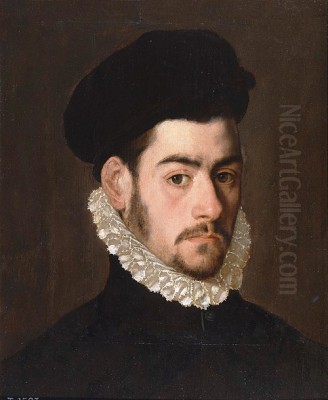
Alonso Sánchez Coello stands as a pivotal figure in the history of Spanish art, particularly during the vibrant yet austere period of the late Renaissance under the reign of King Philip II. Active primarily in the second half of the 16th century (circa 1531-1588), he is widely celebrated as one of the principal founders and foremost practitioners of the formal Spanish court portrait tradition. His work not only captured the likenesses of the powerful Habsburg rulers and their entourages but also defined an enduring visual language of power, piety, and dynastic identity that would influence generations of artists to come.
Born near Valencia, Sánchez Coello's artistic journey took him from the Iberian Peninsula to the heart of artistic developments in Flanders and back, allowing him to synthesize diverse influences into a unique and compelling style. Serving as Philip II's trusted court painter (Pintor de Cámara), he produced a remarkable body of work characterized by meticulous detail, psychological insight, and an elegant sobriety perfectly attuned to the tastes of the Spanish monarchy. His legacy is cemented not only by his own masterpieces but also by the profound impact he had on his pupils and successors, most notably the great Diego Velázquez.
Formative Years: From Valencia to the Flemish Masters
Alonso Sánchez Coello's story begins around 1531 in Benifaió de Valls, a small town near Valencia, Spain. His early life, though not extensively documented, took a significant turn following the death of his father. Young Alonso moved to Portugal, where his grandfather served at the court in Lisbon. This relocation proved crucial, as it was in Portugal that he received his initial education and likely his first exposure to the world of courtly art and patronage, possibly under the auspices of King John III.
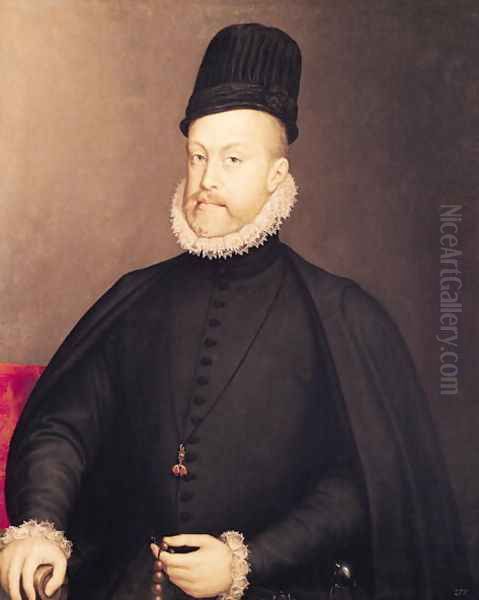
The most decisive phase of his artistic training, however, occurred outside Iberia. Recognizing his talent, Sánchez Coello was sent, likely with royal support, to Flanders around 1550 to study under the celebrated portraitist Anthonis Mor van Dashorst, known in Spain as Antonio Moro. Mor, a native of Utrecht who had achieved international fame, was himself working for the Habsburgs, including Philip II (then Prince Philip). Studying in Mor's Brussels workshop exposed Sánchez Coello directly to the height of the Northern Renaissance portrait tradition.
Antonis Mor was renowned for his sharp realism, objective rendering of textures, and profound psychological penetration, capturing the sitter's presence and status with unerring accuracy. He masterfully combined the meticulous detail inherited from earlier Flemish masters like Jan van Eyck and Rogier van der Weyden with a compositional grandeur suited to aristocratic representation. Sánchez Coello absorbed these lessons deeply, mastering the precise technique, the careful modeling of features, and the ability to convey gravitas that characterized his teacher's work. This Flemish foundation would remain central to his art throughout his career.
Return to Iberia and Royal Patronage
After his formative years studying with Antonis Mor in Flanders, Sánchez Coello returned to the Iberian Peninsula. Initially, he resumed service at the Portuguese court of King John III in Lisbon for a few years. His talent was already evident, and he began establishing his reputation as a skilled portraitist. However, his connection to Mor and the Habsburg network soon led him to a grander stage.
Around 1555, or perhaps slightly later, Sánchez Coello moved to Spain, drawn to the court of Philip II. This move coincided with Antonis Mor's departure from Spain. Mor had served Philip II but left the king's service under circumstances that remain somewhat unclear. Sánchez Coello effectively stepped into the void left by his master, quickly gaining favour with the discerning monarch. Philip II, a significant patron of the arts known for his sober piety and meticulous nature, found in Sánchez Coello an artist whose style resonated with the desired image of the Spanish monarchy: dignified, formal, yet realistic.
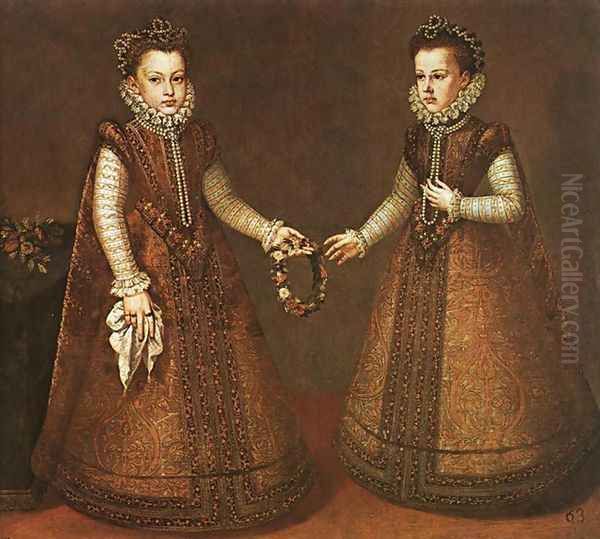
The context of Philip II's court was crucial. It was an era defined by the Counter-Reformation, the vastness of the Spanish Empire, and the monumental project of building the Escorial palace-monastery. Art was not merely decorative; it was a tool for projecting power, asserting Catholic orthodoxy, and documenting the lineage of the Habsburg dynasty. Sánchez Coello's ability to fulfill these requirements with technical brilliance and aesthetic refinement secured his position. By 1560, he was officially appointed Pintor de Cámara, the King's premier court painter, a prestigious role he would hold until his death.
His relationship with Philip II appears to have been one of mutual respect and trust. Contemporary accounts suggest the king held Sánchez Coello in high esteem, sometimes visiting his studio within the palace complex. This close access allowed the artist to create numerous intimate yet formal portraits of the king, his family, and the highest echelons of the Spanish nobility, solidifying his role as the chief visual chronicler of the Habsburg court.
Defining the Habsburg Image: Style and Technique
Alonso Sánchez Coello forged a distinctive artistic style that became the benchmark for Spanish court portraiture. His genius lay in his ability to synthesize the meticulous realism and psychological acuity learned from Antonis Mor with the richer colours, softer modeling, and more sensuous textures associated with the Venetian school, particularly the work of Titian. Titian himself was highly favoured by Philip II's father, Emperor Charles V, and later by Philip II, and his influence permeated the artistic atmosphere of the Spanish court. Sánchez Coello navigated these influences skillfully, creating portraits that were both formally imposing and subtly human.
A hallmark of Sánchez Coello's technique is the extraordinary attention to detail, especially in the rendering of fabrics, jewels, lace, and armour. He captured the specific textures of silk, velvet, damask, and metal with painstaking precision, contributing to the overall sense of realism and conveying the immense wealth and status of his sitters. This Flemish-inspired exactitude was combined with a sophisticated use of light and shadow, often creating a subtle chiaroscuro that modeled faces and forms with sensitivity.
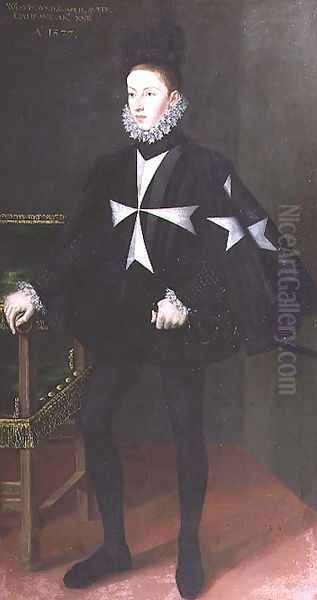
While adhering to the strict protocols of courtly representation – typically featuring formal, somewhat stiff poses and restrained gestures – Sánchez Coello managed to imbue his portraits with a sense of individual personality. His sitters, though presented with the requisite Habsburg dignity and seriousness (gravedad), often reveal hints of their inner life through their gaze or the subtle modeling of their features. He avoided overt flattery but excelled at capturing a convincing likeness that conveyed both the office and the person. Compared to the sometimes more stylized elegance of Italian Mannerist portraitists like Agnolo Bronzino, Sánchez Coello maintained a greater degree of objective observation.
His compositions are typically elegant and balanced, often featuring the sitter standing or seated against a dark, neutral background, or occasionally incorporating symbolic props like columns, draped curtains, or a table. His colour palette, while often dominated by the blacks and dark tones favoured by the Spanish court for their connotations of sobriety and piety, could also incorporate rich reds, golds, and whites, particularly in the depiction of ceremonial attire or female dress. This careful balance between Flemish precision, Venetian colour, and Spanish austerity defined the Habsburg image for decades.
Masterworks: Portraits of Power and Piety
Sánchez Coello's tenure as Philip II's court painter resulted in a significant corpus of work, primarily focused on portraiture, though he also undertook religious commissions. His portraits of the royal family are among his most celebrated achievements, serving as official records and powerful statements of dynastic continuity.
Key examples include his numerous portraits of King Philip II. Often depicted half-length or three-quarter length, clad in his characteristic black attire sometimes relieved by the Order of the Golden Fleece, these portraits convey the monarch's intense piety, seriousness, and unwavering authority. While clearly indebted to the models established by Antonis Mor, Sánchez Coello's depictions often possess a slightly softer, warmer quality.
He also painted poignant portraits of Philip's ill-fated son, Prince Don Carlos. These images capture the young prince's physical frailties and perhaps hint at the psychological turmoil that marked his short life, demonstrating Sánchez Coello's capacity for subtle characterization even within the constraints of formal portraiture.
Perhaps his most charming and widely recognized works are the portraits of Philip II's daughters by his third wife, Elisabeth of Valois: the Infantas Isabel Clara Eugenia and Catalina Micaela. Painted individually and together, often adorned in incredibly elaborate court dresses rendered with astonishing detail, these portraits are masterpieces of texture and pattern. Beyond mere likenesses, they project an image of youthful dignity, dynastic importance, and the wealth of the Spanish Empire. The famous double portrait in the Prado Museum is a prime example.
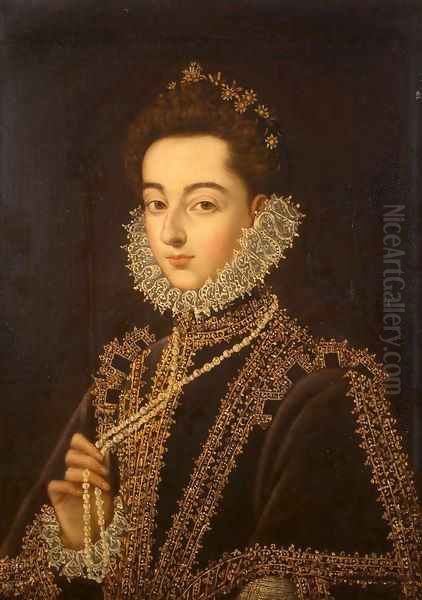
Other important royal commissions included portraits of Philip II’s fourth wife, Anne of Austria, and various other members of the extended Habsburg family and the high nobility. The painting known as 'The Lady in a Fur Wrap' (Museo Pollok House, Glasgow), once famously attributed to El Greco, is now generally accepted as a work by Sánchez Coello, showcasing his ability to capture female beauty and personality with sensitivity and rich textural effects.
Beyond portraiture, Sánchez Coello contributed religious paintings, notably for the vast decorative program of the Escorial. He worked alongside other artists favoured by Philip II, such as the Italian painters Luca Cambiaso and Federico Zuccaro, and the Spanish painter Juan Fernández Navarrete, known as "El Mudo" (The Mute). Sánchez Coello's religious works, such as altarpieces depicting saints or sacred scenes, often show a stronger Italian influence, reflecting the prevailing trends in religious art during the Counter-Reformation. Unfortunately, many of his works, including potential frescoes and paintings housed in royal residences like the Pardo Palace, were lost to fires over the centuries.
While primarily a figure painter, occasional works like the 'Typical Impression of the Port of Seville' suggest a broader range, though portraiture remained his central focus and the area of his most lasting impact.
Artistic Circle: Contemporaries, Influences, and Rivals
Alonso Sánchez Coello operated within a rich and complex artistic milieu, interacting with, influenced by, and sometimes competing against other prominent artists of his time. His career cannot be fully understood without considering this network of relationships.
His most significant relationship was undoubtedly with his teacher, Antonis Mor. Mor provided the technical foundation and stylistic model that Sánchez Coello adapted and built upon. He essentially inherited Mor's position at the Spanish court, continuing the tradition of highly detailed, psychologically astute Habsburg portraiture.
The influence of Titian was pervasive, though perhaps less direct than Mor's. Titian's portraits of Charles V and Philip II had set a standard for imperial grandeur, and his mastery of colour and brushwork offered a counterpoint to Flemish linearity. Sánchez Coello absorbed elements of Titian's approach, particularly in the handling of light and the creation of atmosphere, blending it with Mor's precision.
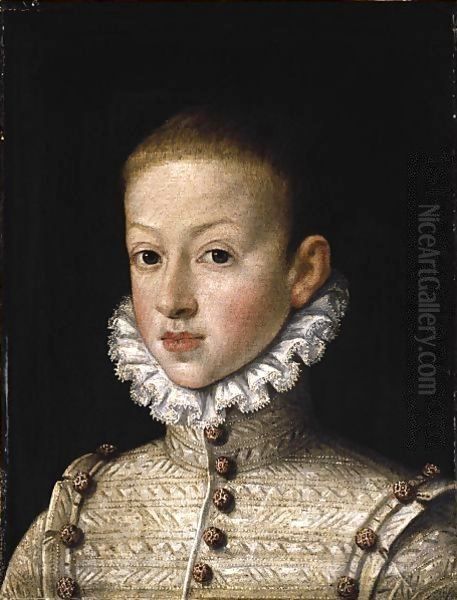
Within the Spanish court itself, Sánchez Coello had contemporaries and potential rivals. Sofonisba Anguissola, the talented Italian noblewoman and painter from Cremona, served as a lady-in-waiting to Queen Elisabeth of Valois and was also active as a portraitist at court during the earlier part of Coello's tenure. While both artists worked in portraiture, Sánchez Coello's official position as Pintor de Cámara and his more formal, objective style seem to have aligned more closely with Philip II's long-term preferences for official state portraits, though Anguissola's contributions were highly valued.
Juan Fernández Navarrete ("El Mudo") was another major figure working for Philip II, primarily focused on large-scale religious commissions for the Escorial. Navarrete, influenced by Venetian art, particularly Titian and Tintoretto, brought a different sensibility to the court's artistic projects. While their primary genres differed, Sánchez Coello and Navarrete would have certainly been aware of each other's work, particularly within the context of the Escorial's decoration.
Later in Sánchez Coello's career, El Greco (Doménikos Theotokópoulos) arrived in Spain (around 1577). El Greco's intensely personal, spiritual, and anti-naturalistic style stood in stark contrast to Sánchez Coello's courtly realism. Although El Greco sought royal patronage, his style did not find favour with Philip II for major commissions at the Escorial, leaving Sánchez Coello and the more Italianate painters largely dominant in the official sphere during this period.
Other Spanish artists active during parts of Coello's lifetime include Luis de Morales, known as "El Divino," famed for his intensely devotional religious paintings, representing a different facet of Spanish artistic production focused on piety rather than courtly representation. Sánchez Coello's work, therefore, should be seen within this dynamic context of Flemish inheritance, Venetian influence, Italian presence, and native Spanish traditions.
Legacy and Enduring Influence
Alonso Sánchez Coello's death in Madrid in 1588 marked the end of a remarkably successful career, but his influence extended far beyond his lifetime. He played a crucial role in establishing a distinctively Spanish school of portraiture, characterized by its blend of objective realism, formal dignity, and psychological depth. This tradition would dominate Spanish art for decades and lay the groundwork for its Golden Age.
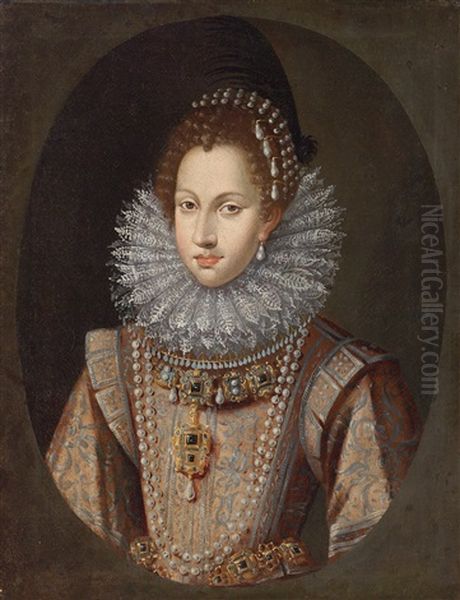
His most immediate legacy was carried on by his pupils and workshop assistants. Chief among them was Juan Pantoja de la Cruz, who had worked closely with Coello for many years and eventually succeeded him as Pintor de Cámara to Philip II and later Philip III. Pantoja continued Coello's style, perhaps with an even greater emphasis on the minute rendering of costume and jewels, sometimes at the expense of psychological subtlety, but firmly maintaining the established formula for Habsburg representation. Another follower was Felipe de Liaño, known for his miniatures.
The impact of Sánchez Coello's work, however, reached its zenith in the following century with Diego Velázquez. Velázquez, arriving at the court of Philip IV, inherited the tradition of formal court portraiture largely shaped by Coello and Pantoja. While Velázquez would ultimately transcend this tradition with his revolutionary technique and profound humanism, his early court portraits clearly show the influence of his predecessors in their compositional structures, formal poses, and emphasis on conveying status. Velázquez studied the royal collections, which were rich in works by Coello, absorbing lessons in technique and representation before forging his own path. The lineage from Mor through Coello and Pantoja to Velázquez represents the central spine of Spanish court portraiture.
Later artists like Bartolomé González y Serrano also continued working in a style heavily indebted to Coello and Pantoja well into the 17th century, demonstrating the longevity of the aesthetic established by Philip II's favoured painter.
Beyond Spain, Sánchez Coello's works were disseminated through copies and were known in other European courts connected to the Habsburgs. Today, his paintings are held in major international museums, including the Prado Museum in Madrid (which holds the most significant collection), the Kunsthistorisches Museum in Vienna, the National Gallery in London, and others, ensuring his continued recognition as a master of Renaissance portraiture.
Personal Glimpses
Compared to the detailed record of his artistic output and official duties, information about Alonso Sánchez Coello's personal life remains relatively scarce. Born circa 1531 and dying in Madrid in 1588, his life spanned a period of immense political and cultural significance for Spain. His professional life was intrinsically tied to the rhythms and demands of the royal court, where he spent the majority of his mature career.
Sources sometimes differ on his marital status. While some earlier accounts suggested he remained unmarried, it is now generally accepted that he did marry, and importantly, his daughter, Isabel Sánchez Coello (c. 1564–1612), followed in his footsteps. She became a painter herself, specializing in portraiture and likely trained by her father. Her existence points to a family life intertwined with the artistic profession, continuing the tradition within the Coello household.
The anecdote of King Philip II frequently visiting Sánchez Coello's studio suggests a relationship that went beyond mere patronage, hinting at a degree of personal favour and accessibility unusual for the typically remote monarch. This implies a personality that was not only artistically skilled but also capable of navigating the complex etiquette and politics of the court environment successfully.
Despite the lack of colourful anecdotes or detailed personal writings, Sánchez Coello's life story is primarily told through his art and his dedicated service to the Spanish crown. He appears as a figure of immense talent, discipline, and adaptability, who successfully synthesized diverse artistic currents to meet the specific needs of his powerful patrons, leaving behind a legacy defined by professional achievement and artistic excellence. His death in Madrid concluded a career that had decisively shaped the visual identity of one of Europe's most powerful monarchies.
Conclusion: A Cornerstone of Spanish Art
Alonso Sánchez Coello occupies a position of fundamental importance in Spanish art history. As the chosen portraitist of Philip II, he was tasked with creating the official image of the Spanish Habsburg monarchy during a period of immense global power and stringent Catholic orthodoxy. He fulfilled this role with exceptional skill, establishing a mode of court portraiture that perfectly balanced meticulous realism, formal dignity, psychological insight, and the opulent display of status.
By masterfully blending the precision learned from his Flemish master Antonis Mor with the chromatic richness and sensitivity associated with Venetian painters like Titian, Sánchez Coello created a unique and enduring style. His portraits of kings, queens, princes, and infantas are not merely likenesses; they are carefully constructed statements about power, lineage, piety, and the specific cultural identity of the Spanish court, characterized by its solemnity and gravedad.
His influence was profound and lasting. He trained successors like Juan Pantoja de la Cruz, ensuring the continuation of his stylistic approach, and his work served as a crucial precedent for the towering genius of Diego Velázquez in the following century. Though perhaps overshadowed in popular recognition by later masters of the Spanish Golden Age, Sánchez Coello remains a cornerstone figure, the artist who most definitively captured and shaped the visual representation of the Spanish Habsburgs at the height of their power. His legacy endures in the magnificent portraits that continue to gaze out from the walls of the world's great museums.